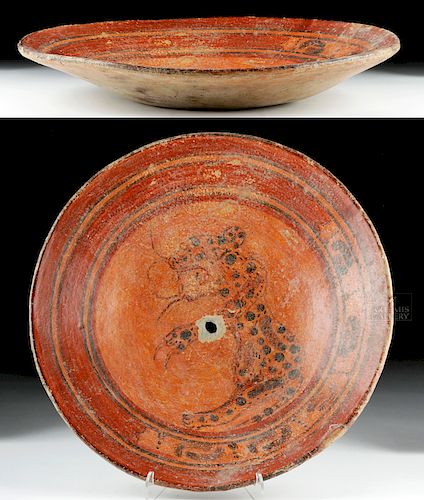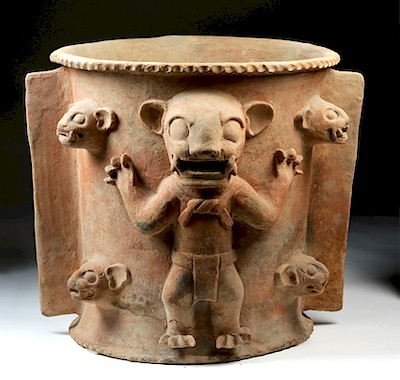Mayan Polychrome Dish with Jaguar - Kill Hole
Lot 93a
About Seller
Artemis Fine Arts
686 S Taylor Ave, Ste 106
Louisville, CO 80027
United States
Selling antiquities, ancient and ethnographic art online since 1993, Artemis Gallery specializes in Classical Antiquities (Egyptian, Greek, Roman, Near Eastern), Asian, Pre-Columbian, African / Tribal / Oceanographic art. Our extensive inventory includes pottery, stone, metal, wood, glass and textil...Read more
Estimate:
$2,000 - $3,000
Absentee vs Live bid
Two ways to bid:
- Leave a max absentee bid and the platform will bid on your behalf up to your maximum bid during the live auction.
- Bid live during the auction and your bids will be submitted real-time to the auctioneer.
Bid Increments
| Price | Bid Increment |
|---|---|
| $0 | $25 |
| $300 | $50 |
| $1,000 | $100 |
| $2,000 | $250 |
| $5,000 | $500 |
| $10,000 | $1,000 |
| $20,000 | $2,500 |
| $50,000 | $5,000 |
| $100,000 | $10,000 |
| $200,000 | $20,000 |
About Auction
By Artemis Fine Arts
Dec 6, 2018
Set Reminder
2018-12-06 10:00:00
2018-12-06 10:00:00
America/New_York
Bidsquare
Bidsquare : DAY 2 : Pre-Columbian, Ethnographic & Fine Art
https://www.bidsquare.com/auctions/artemis-gallery/day-2-pre-columbian-ethnographic-fine-art-3699
Day 2 of an important 2-dy auction featuring ancient and ethnographic art from around the world. Today's sale will feature Pre-Columbian, Native American, African / Tribal, Ethnographic, Spanish Colonial, Fine Art, much more. Artemis Fine Arts info@artemisgallery.com
Day 2 of an important 2-dy auction featuring ancient and ethnographic art from around the world. Today's sale will feature Pre-Columbian, Native American, African / Tribal, Ethnographic, Spanish Colonial, Fine Art, much more. Artemis Fine Arts info@artemisgallery.com
- Lot Description
Pre-Columbian, southern Mexico and northern Central America, Mayan Territories, Late Classic, ca. 550 to 900 CE. A distinctive, flat-bottomed plate with flared sides and a central motif in tondo of a stalking jaguar, drilled through with a "kill hole". The jaguar claws, especially on the visible front paw, are emphasized, as are the teeth, giving an impression of power and fierceness. Around this central motif is a ring of glyphs spaced out with bands of deep, earthy red. These glyphs are repetitive and may by the name of the owner of the bowl or the one who commissioned it. Size: 13.95" W x 2.45" H (35.4 cm x 6.2 cm)
The form of the jaguar was revered throughout the Pre-Columbian New World as the mightiest wild feline and was used as a symbol of power and kingship. In Classic Maya art, the jaguar is associated with lordly might and as an avatar for the gods. Many rulers during this time took jaguar names: Shield-Jaguar and Bird-Jaguar, for example. One of the Hero Twins described in the Quiche book Popol Voh, the most famous Maya text, is named Xbalanque, which is almost certainly derived from the word for jaguar, "balam", and that twin is shown in art with jaguar pelt markings on his face and body.
Provenance: private Southern California, USA collection, acquired in the 1970s to mid-1980s
All items legal to buy/sell under U.S. Statute covering cultural patrimony Code 2600, CHAPTER 14, and are guaranteed to be as described or your money back.
A Certificate of Authenticity will accompany all winning bids.
We ship worldwide and handle all shipping in-house for your convenience.
#140757With two stable cracks on the base, otherwise in very good condition, with nice remaining pigment. "Kill hole" drilled through center. Wonderful root marks and light deposits.Condition
- Shipping Info
-
All shipping is handled in-house for your convenience. Your invoice from Artemis Gallery will include shipping calculation instructions. If in doubt, please inquire BEFORE bidding for estimated shipping costs for individual items.
-
- Buyer's Premium



 EUR
EUR CAD
CAD AUD
AUD GBP
GBP MXN
MXN HKD
HKD CNY
CNY MYR
MYR SEK
SEK SGD
SGD CHF
CHF THB
THB

















